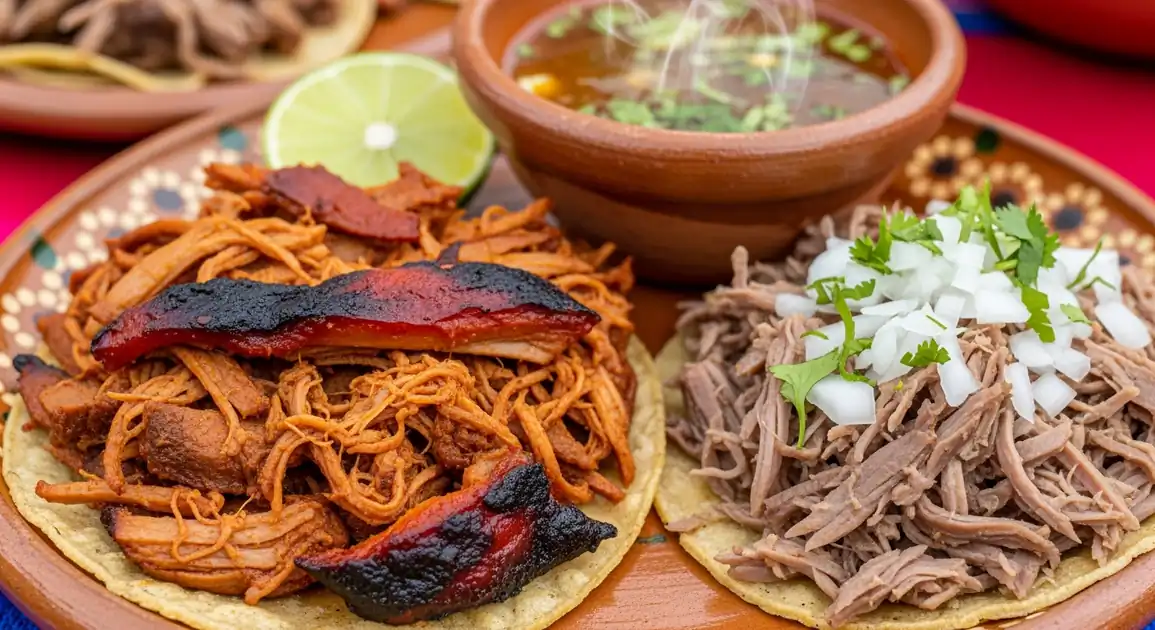Goat Barbacoa
Barbacoa de Chivo

Description
Barbacoa is a beloved weekend tradition across Mexico, with regional variations in meat (goat, lamb, beef) and preparation. Goat barbacoa ('de chivo') is particularly prominent in states like Oaxaca, Puebla, Guerrero, and parts of Northern Mexico. It's commonly found in markets, roadside stands, and specialized restaurants, especially on Saturdays and Sundays.
Dietary Information
Serving information
Serving style
Served hot, typically shredded or chopped. Eaten as tacos on warm corn tortillas, garnished with chopped onion, cilantro, lime, and salsa. Often accompanied by a cup of hot consommé. Can also be bought by weight with tortillas on the side.
Quick facts
Primarily weekend mornings and early afternoons (approx. 8 AM - 2 PM or until sold out).
Safety Tips
What to Look For
-
Meat kept visibly steaming hot
Ensures the meat is held at a safe temperature (above 60°C / 140°F) to prevent bacterial growth. Look for steam rising from the pot or serving container.
-
Consommé served piping hot
The broth should be very hot, not lukewarm. This indicates proper temperature control and enhances safety and flavor.
-
Clean serving area and utensils
Check for clean cutting boards (ideally separate for raw/cooked, though barbacoa is usually handled cooked), knives, condiment containers, and vendor hand hygiene.
-
High customer turnover (busy vendor)
Popular stalls usually mean the food is fresh and doesn't sit around for long periods. Locals lining up is often a good sign.
-
Vendor reputation (ask locals)
If possible, ask locals for recommendations. Established vendors known for quality are generally safer bets.
What to avoid
-
Meat sitting out at room temperature or looking dry/old
Barbacoa should be moist and kept hot. Avoid vendors where the meat looks like it's been sitting uncovered or unheated for a while.
-
Lukewarm consommé
Broth not kept sufficiently hot poses a food safety risk.
-
Dirty stall or poor vendor hygiene
Visible grime, flies, or vendors handling money and food without washing hands/using gloves are red flags.
-
Re-heated barbacoa (unless done properly)
Freshly cooked or properly hot-held barbacoa is best. Be cautious if it seems like leftovers are being quickly reheated.
Price information
Price range
Budget tips
- Buying by weight ('por kilo') is usually more economical for groups than individual tacos.
- Market stalls and roadside stands tend to be cheaper than established restaurants.
- Prices are typically per taco or per kilo (includes meat and tortillas). Consommé might be included or a small extra charge.
- Look for 'paquetes' (packages) that might include meat, consommé, tortillas, and salsas.
Value indicators
- Tender, moist meat.
- Flavorful, hot consommé.
- Fresh tortillas and condiments (onion, cilantro, lime, salsa).
- Generous portions per taco or kilo.
- Clear indication if cooked 'en pozo'.
Where to Find This Dish
Traditional Markets ('Mercados')
Designated food sections within local markets are prime spots.
Local town/city market
Weekend mornings (8 AM - 1 PM)
Roadside Stands ('Puestos en carretera')
Commonly found along major roads outside towns, attracting travelers.
Highway shoulders, Town entrances/exits
Weekend mornings
Specialty Restaurants ('Barbacoerías')
Dedicated eateries often open only on weekends.
Restaurants with 'Barbacoa' signs
Weekend lunchtimes (10 AM - 3 PM)
Vendor Tips
- Arrive relatively early (e.g., before noon) on weekends, as popular vendors can sell out.
- Specify if you want 'maciza' (lean meat) or 'surtido' (mix including fattier parts), if offered.
- Don't be shy about asking for a sample ('una prueba') if offered.
How to Order
Regional Variations
-
Barbacoa de Borrego
(Barbacoa de Borrego)
The same slow-cooking technique applied to lamb or sheep meat. More common in Central Mexico (e.g., Hidalgo, State of Mexico).
-
Birria de Chivo (Jalisco style)
(Birria de Chivo Estilo Jalisco)
While also slow-cooked goat, Birria is typically stewed (often in a pot rather than a pit) with a different adobo profile, sometimes including tomatoes, and often served as a soupier stew or crispy 'quesabirria' tacos.
-
Barbacoa variations by Adobo
(Variaciones de Adobo)
The specific blend of chilies (e.g., ancho, guajillo, pasilla) and spices in the marinade can vary significantly by region and cook, affecting color and flavor.
-
Barbacoa Blanca
(Barbacoa Blanca)
A less common variation, typically cooked with minimal seasoning or chilies, focusing purely on the meat flavor enhanced by maguey leaves and salt.
Cultural context
History
The term 'barbacoa' originates from the Taíno word 'barabicu', referring to slow-cooking meat over a fire or in a pit. This technique was adopted and adapted across Mexico, utilizing local meats and ingredients. Cooking barbacoa, especially for celebrations and weekend gatherings, is a deeply rooted tradition. Goat ('chivo') became a popular choice in regions suited for goat herding, like the semi-arid landscapes of Oaxaca, evolving into a distinct regional specialty.
Local significance
Barbacoa represents community, celebration, and tradition. It's a communal food often shared among families and friends, especially on weekends.
Eating customs
- Sipping the hot consommé alongside the tacos.
- Generously adding condiments (onion, cilantro, lime, salsa).
- Often eaten standing at market stalls or seated at communal tables.